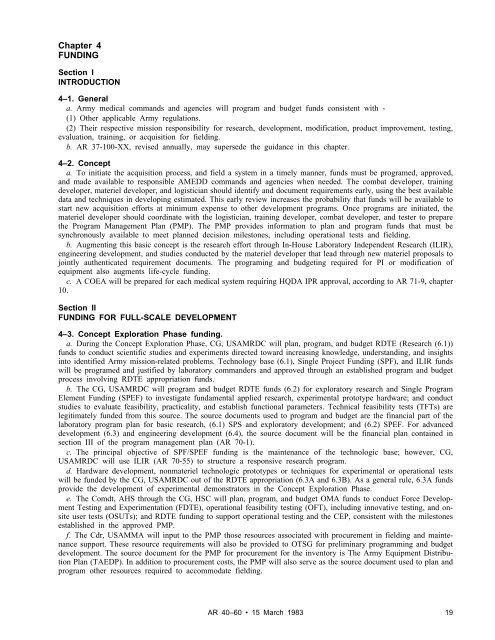policies and procedures for the acquisition of medical materiel
policies and procedures for the acquisition of medical materiel
policies and procedures for the acquisition of medical materiel
You also want an ePaper? Increase the reach of your titles
YUMPU automatically turns print PDFs into web optimized ePapers that Google loves.
Chapter 4FUNDINGSection IINTRODUCTION4–1. Generala. Army <strong>medical</strong> comm<strong>and</strong>s <strong>and</strong> agencies will program <strong>and</strong> budget funds consistent with -(1) O<strong>the</strong>r applicable Army regulations.(2) Their respective mission responsibility <strong>for</strong> research, development, modification, product improvement, testing,evaluation, training, or <strong>acquisition</strong> <strong>for</strong> fielding.b. AR 37-100-XX, revised annually, may supersede <strong>the</strong> guidance in this chapter.4–2. Concepta. To initiate <strong>the</strong> <strong>acquisition</strong> process, <strong>and</strong> field a system in a timely manner, funds must be programed, approved,<strong>and</strong> made available to responsible AMEDD comm<strong>and</strong>s <strong>and</strong> agencies when needed. The combat developer, trainingdeveloper, <strong>materiel</strong> developer, <strong>and</strong> logistician should identify <strong>and</strong> document requirements early, using <strong>the</strong> best availabledata <strong>and</strong> techniques in developing estimated. This early review increases <strong>the</strong> probability that funds will be available tostart new <strong>acquisition</strong> ef<strong>for</strong>ts at minimum expense to o<strong>the</strong>r development programs. Once programs are initiated, <strong>the</strong><strong>materiel</strong> developer should coordinate with <strong>the</strong> logistician, training developer, combat developer, <strong>and</strong> tester to prepare<strong>the</strong> Program Management Plan (PMP). The PMP provides in<strong>for</strong>mation to plan <strong>and</strong> program funds that must besynchronously available to meet planned decision milestones, including operational tests <strong>and</strong> fielding.b. Augmenting this basic concept is <strong>the</strong> research ef<strong>for</strong>t through In-House Laboratory Independent Research (ILIR),engineering development, <strong>and</strong> studies conducted by <strong>the</strong> <strong>materiel</strong> developer that lead through new <strong>materiel</strong> proposals tojointly au<strong>the</strong>nticated requirement documents. The programing <strong>and</strong> budgeting required <strong>for</strong> PI or modification <strong>of</strong>equipment also augments life-cycle funding.c. A COEA will be prepared <strong>for</strong> each <strong>medical</strong> system requiring HQDA IPR approval, according to AR 71-9, chapter10.Section IIFUNDING FOR FULL-SCALE DEVELOPMENT4–3. Concept Exploration Phase funding.a. During <strong>the</strong> Concept Exploration Phase, CG, USAMRDC will plan, program, <strong>and</strong> budget RDTE (Research (6.1))funds to conduct scientific studies <strong>and</strong> experiments directed toward increasing knowledge, underst<strong>and</strong>ing, <strong>and</strong> insightsinto identified Army mission-related problems. Technology base (6.1), Single Project Funding (SPF), <strong>and</strong> ILIR fundswill be programed <strong>and</strong> justified by laboratory comm<strong>and</strong>ers <strong>and</strong> approved through an established program <strong>and</strong> budgetprocess involving RDTE appropriation funds.b. The CG, USAMRDC will program <strong>and</strong> budget RDTE funds (6.2) <strong>for</strong> exploratory research <strong>and</strong> Single ProgramElement Funding (SPEF) to investigate fundamental applied research, experimental prototype hardware; <strong>and</strong> conductstudies to evaluate feasibility, practicality, <strong>and</strong> establish functional parameters. Technical feasibility tests (TFTs) arelegitimately funded from this source. The source documents used to program <strong>and</strong> budget are <strong>the</strong> financial part <strong>of</strong> <strong>the</strong>laboratory program plan <strong>for</strong> basic research, (6.1) SPS <strong>and</strong> exploratory development; <strong>and</strong> (6.2) SPEF. For advanceddevelopment (6.3) <strong>and</strong> engineering development (6.4), <strong>the</strong> source document will be <strong>the</strong> financial plan contained insection III <strong>of</strong> <strong>the</strong> program management plan (AR 70-1).c . T h e p r i n c i p a l o b j e c t i v e o f S P F / S P E F f u n d i n g i s t h e m a i n t e n a n c e o f t h e t e c h n o l o g i c b a s e ; h o w e v e r , C G ,USAMRDC will use ILIR (AR 70-55) to structure a responsive research program.d. Hardware development, non<strong>materiel</strong> technologic prototypes or techniques <strong>for</strong> experimental or operational testswill be funded by <strong>the</strong> CG, USAMRDC out <strong>of</strong> <strong>the</strong> RDTE appropriation (6.3A <strong>and</strong> 6.3B). As a general rule, 6.3A fundsprovide <strong>the</strong> development <strong>of</strong> experimental demonstrators in <strong>the</strong> Concept Exploration Phase.e. The Comdt, AHS through <strong>the</strong> CG, HSC will plan, program, <strong>and</strong> budget OMA funds to conduct Force DevelopmentTesting <strong>and</strong> Experimentation (FDTE), operational feasibility testing (OFT), including innovative testing, <strong>and</strong> onsiteuser tests (OSUTs); <strong>and</strong> RDTE funding to support operational testing <strong>and</strong> <strong>the</strong> CEP, consistent with <strong>the</strong> milestonesestablished in <strong>the</strong> approved PMP.f. The Cdr, USAMMA will input to <strong>the</strong> PMP those resources associated with procurement in fielding <strong>and</strong> maintenancesupport. These resource requirements will also be provided to OTSG <strong>for</strong> preliminary programming <strong>and</strong> budgetdevelopment. The source document <strong>for</strong> <strong>the</strong> PMP <strong>for</strong> procurement <strong>for</strong> <strong>the</strong> inventory is The Army Equipment DistributionPlan (TAEDP). In addition to procurement costs, <strong>the</strong> PMP will also serve as <strong>the</strong> source document used to plan <strong>and</strong>program o<strong>the</strong>r resources required to accommodate fielding.AR 40–60 • 15 March 198319
















